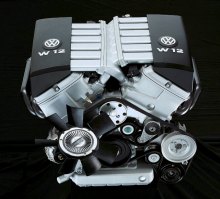
Explained: Volkswagen's VR6, W12 and W18 Engines
The W12, W16 and W18 engines are in fact yesterday's news, but we thought we'd just refresh you with a in-depth tech article about the W engines, how it works and its VW VR6 roots.
Source: AutoZine Technical School - ENGINE
First generation VR6
6 cylinder engines, no matter in Vee-shape or arranged inline, has superior smoothness against an inline 4-cylinder because all the first order and second order forces can be balanced. However, for most small cars, they don't have the space to accommodate 6-cylinder engines. For space efficiency reason, nearly all small cars employ front-engined + front-wheel-drive configuration, that is, FF. The engine, clutch, gearbox and differential are all installed up front, accompany with ABS pump, servo, air-conditioning, battery and steering mechanism etc. Therefore it is not easy to fit a six-cylinder engine into the car. Especially is straight-six which is too long for FF because the gearbox and clutch has to be installed right beside it. Even the big Volvo S80 has to specially develop a compact gearbox. V6 could be better because it is very much shorter, at least it can be fitted to Rover 400
Undoubtedly, engines for small cars have to be mounted transversely, unless it is BMW 3-series Compact which has a long long bonnet (hence poor poor space efficiency). But even mounting transversely can’t guarantee the installation of a V6. The width of V6 (excluding accessory) is at least doubled from inline-six, depends on the incline angle (usually 60° or 90°), so it engages a lot of length of the engine compartment. Moreover, the hot exhaust pipes in either side of the Vee also prevent any other components from placing too near, thus need more clearance. Therefore most small cars cannot accommodate V6.
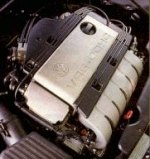
In 1991, a breakthrough was achieved by Volkswagen. It developed a narrow-angle (15°) V6 displacing as much as 2.8 litres and installed it to the generation 3 Golf. As everybody knows, this is the so-called "VR6". As seen in the picture, the VR6 is really very compact, nearly as narrow as any inline engine and not much longer than a straight-4. It could be fitted to many small cars, including Polo (which didn’t because of price reason). It is also supplied to Mercedes-Benz V-class, whose short front end cannot fit Mercedes’ own V6.
VR6 could be as narrow as 15° without cylinders overlapping is because adjacent cylinders are widely spaced from each other, as seen in the following pictures. This inevitably increase its length but the result is still just equals to 4 and a half cylinder, versus a V6’s 3 and a half. For most small cars this is short enough.
<table id="table1" border="0" cellpadding="10" cellspacing="0" width="90%"> <tbody><tr> <td>
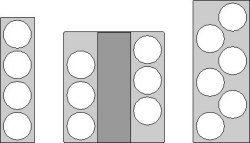
</td> <td> Comparision between a straight-4, V6 and a VR6's cylinder block, viewing from above. The V6 has the length equals to 3 and a half cylinder in-line. The VR6 approaches 4 and a half, however, it is a lot narrower.
</td> </tr> </tbody></table>
Asymmetric Configuration
Another feature of VR6 is very important for our further study of 24-valve VR6 and W-engines. It is: the VR6 is asymmetric. For conventional V6, one bank of cylinders mirrors another bank, that means, air intake from the center of the V and exhaust pumps out from outside of the V. (Not vice versa, because the inside of V cannot accommodate the very hot exhaust pipes.) Now please see the illustration in below ....
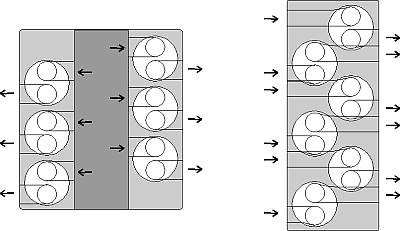
Left : Symmetric design of V6 Right : Asymmetric design of VR6
... the VR6 has the air intake from one side and exhaust from another side for ALL cylinders, no matter in which bank, so it is not a symmetric design. Normally, induction manifolds take place at the top of the engine thus waste no space, it is the hot exhaust pipes that engage a lot of space (or length) of the car, especially is a certain clearance should be provided to avoid overheating to surrounding components. Now VR6 concentrate all the exhaust pipes to one side of the engine, thus save space.
The same cannot be implemented to conventional V6s because their adjacent cylinders are packed so close to each other thus provide no space for induction / exhaust pipes running to the same side.
Valve Gear
The first generation VR6 has 2 valves per cylinder, single overhead camshaft (sohc) serving each bank just like any conventional 2-valve V6s, although the 2 camshafts are so close that they look as if a twin-cam design.
Cylinder Head / Block
However, in many ways the VR6 is constructed like an in-line engine. Thanks to the narrow angle, the two banks are merged into a single cylinder block. Also, a single cylinder head houses the valve gears for all 6 cylinders. In contrast, a conventional V6 consists of 2 blocks and 2 heads. As a result, VR6 is not only smaller, but also lighter. It would have been cheaper as well if not employ 7-bearing crankshaft.
<hr align="left" size="1">24-valve VR6
When the whole world is fascinating with 4-valve engines, Volkswagen’s VR engine (both VR6 and V5) still relies on sohc 2-valve head until the arrival of the second generation VR6 in July 1999. You may wonder why it takes 8 years to bring the VR6 a 4-valve head. In fact, there was a very big technical difficulty behind the development.
Technical Difficulties
When I heard the rumour about the 24v VR6 about 2 years ago, the first question arouse in my mind was: how to fit 4 camshafts into the small piece of cylinder head ? It is virtually impossible, especially is that some space has to be preserved for replacing spark plugs. If not having 4 camshafts, then it must be an sohc design serving 4 valves per cylinder, just like many Japanese cars, say, Honda and Mitsubishi.
<table id="table2" border="0" cellpadding="0" cellspacing="0" width="92%"> <tbody><tr> <td>
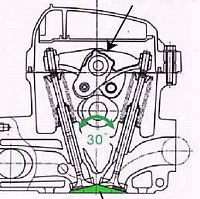
</td> <td> Honda’s SOHC 4-valve engine.
Lelf : Each camshaft has 4 closely packed cams for each cylinder. The cams activate valves via rocker arms.
Right: the complex rocker arms.
</td> <td>
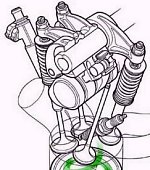
</td> </tr> </tbody></table>
However, sohc 4-valve is not a perfect design. Firstly, it concentrates 3 or 4 elegant, narrow cams to every cylinder, thus relatively complex. Secondly, the most ideal position of a rocker arm / cam set is exactly vertical above the valve it controls. Otherwise the movement may generate a lateral moment which waste power, introduce friction and eventually brings down the rev. For sohc 4-valve, because the ideal position of the rocker arms for intake and exhaust are exactly the same, a small distance shift is introduced to one of them or both of them, thus result in the aforementioned drawback. In fact, all the high performance Honda (from Civic SiR to Type R) employed dohc instead of the sohc of the standard car.
But the most important reason that the sohc 4-valve not desirable is that it doesn’t allow the adoption of cam-phasing variable valve timing. Shift the camshaft 20° in advance leads to the intake valves open and close earlier, but so do the exhaust valves. Therefore there is no gain in performance.
Using cam-changing VVT like VTEC or MIVEC may introduce real performance gain, but as already discussed in the Variable Valve Timing section, it doesn’t improve drivability at low speed thus European car makers are not very interested in.
How did Volkswagen overcome these difficulties ?
Volkswagen's Solution
<table id="table3" border="0" cellpadding="5" cellspacing="0" width="92%"> <tbody><tr valign="top"> <td>
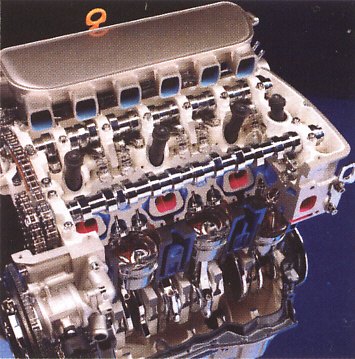
</td> <td> Piech’s ingenious engineers solved the problems by introducing a revolutionary concept: Twin-camshaft per bank, one for intake, one for exhaust, but totalled also 2 camshafts. Yes, believe your eyes. Sometimes 2 x 2 = 2.
Don't believe ? look at the photo beside. Use a single naked eye to look at the farther camshaft. You'll see the rocker arms pressing valve springs, the direction of springs project to the valves of a cylinder belonging to another bank. If you are not sure, see my illustration in below.
</td> </tr> </tbody></table>
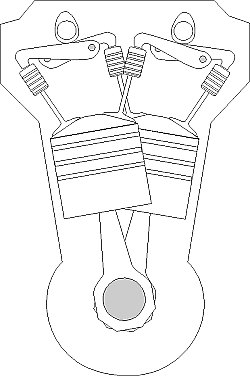
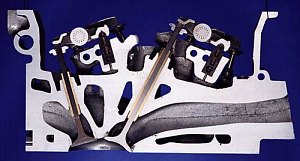
Now it is clear. Camshaft A controls the intake valves of bank A as well as bank B. Similarly, camshaft B controls the exhaust valves in bank B and bank A. In other words, every cylinder is served by both camshafts, hence a twin-cam engine.
If you still remember, a feature of VR6 is that it is asymmetric, this enable the exhaust valves in both bank remains in a distance accessible by a common camshaft. In fact, the distance is the same as in intake valves / cam set. This ensure equal efficiency of intake and exhaust. Without the narrow angle and the asymmetric configuration, the share of camshaft would have been impossible.
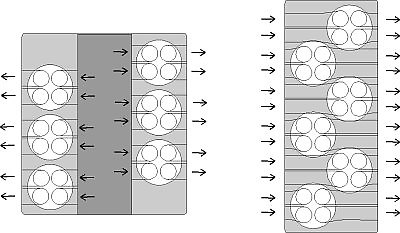
Such design allows cam-phasing variable valve timing to be installed. In the 24-valves VR6, the intake camshaft has VVT. In the future, the exhaust camshaft may also introduce VVT, just like BMW’s Double Vanos.
If it were a conventional V6, it would have needed 4 camshafts, 4 cam-phasing mechanism to implement this. Also required is 2 cylinder blocks and 2 cylinder heads. VR6 needs just half of them.
It is also interesting to see the new VR6 has the same no. of camshaft as its 2-valve predecessor. It is one of the most remarkable invention.
<hr align="left" size="1">W12 engine

Having learned the VR6, it is not difficult to understand the W12. As VW said, the W12 engine shown in the mid-engined W12 supercar is virtually a combination of two VR6s. This is confirmed by its 5.6-litre displacement. It is constructed by mating two 15° VR6 in an inclined angle of 72°. In fact it is the earliest VR engine having 4-valves head, although this car was never put into production.
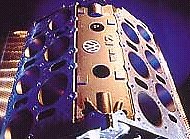
The W configuration would have been never realised if not the invention of VR6. Audi had been researching its own W-engines for years (even showed in the Avus concept car, but the engine was fake) but eventually pulled out the plug. I remember sources said it failed to solve the exhaust / ventilation problems. It was basically formed by 3 banks of 4-cylinder in-line. The problem was how to run the exhaust pipe for the center bank without overheating the surrounding and without wasting too much space.
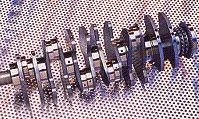
It seems that Volkswagen’s approach is not benefited by Audi’s experience, because the Volkswagen unit is based on the VR6 which was under development well in the 80’s. Benefited by VR6’s asymmetric design, exhaust of the left VR6 runs out from the left side, while exhaust of the right VR6 runs out from the right side. Therefore the exhaust system is just the same as any Vee engine.
The only short-coming of W-engines is that they require very thin connecting rods, as the crankshaft is much shorter than V-engines. While VR6 uses con-rods with 20mm thickness, the W-engines run with 13mm ones. This prevent it from becoming racing engines. Tight cylinder heads may also limit its breathing and ventilation.
<center><hr align="left" size="1"></center>W16 engine
Similar to W12, W16 is made by mating two VR8s together, although at the moment Volkswagen group has not shown any VR8. The VR8 consists of 2 banks of 4-cylinder, mated at 15° just like VR6. The two VR8s then join together at 72°. In other words, W16 is just a W12 with one more cylinder added to each bank.
<center><hr align="left" size="1"></center>W8 engine
The W8 engine was first introduced in Volkswagen Passat W8. As it is produced in the same production line of other modular family members, the basic architecture is the same as W12 and W16. In other words, it is a W12 with 1 cylinder deleted from each bank, or simply half of a W16. W8 consists of a pair of 15° VR4 engines joint to a common crankshaft at 72°.
<center><hr align="left" size="1"></center> W18 engine
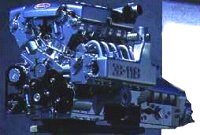
As 18 is not dividable by 4, you know the W-18 is not derived from VR engines. In fact, it follows the old Audi philosophy of mating 3 banks of 6-cylinder, running the common crankshaft. The drawback is: among the 3 banks there are 2 large Vee angles. My estimation is 60° each, hence a total of 120°. For comparison, the W16 is just 15/2 + 72 + 15/2 = 87°, therefore the W-18 is a lot wider. In terms of length, the W16 has the same length as a VR8, that is, about the length of 5 cylinder. The W-18 is as long as an inline-6.
As seen in the photo, the W-18 used by Bugatti EB-218 concept car is very big and complex. Two of the banks mate like a conventional 60° V6 while the remaining bank lays down to horizontal level. Complex induction manifolds and exhaust pipes run between the banks. (note that the exhaust pipes were not fitted to this prototype, otherwise it would have looked even more complex.)
Obviously, W-18 is not as clever as W-16. Although there is no problem of fitting in the jumbo Bugatti saloon, I must question its purpose. Is it more powerful than a V12 can achieve ? No. Is it smoother than the theoretically ideal V12 ? No. Is it shorter than a V12 ? No. Is it narrower than a V12 ? On the contrary. Is it cheaper to be built ? Never.
No wonder Volkswagen eventually decided to terminate the W18 project.
More Pictures of the gorgeous W-Engines
http://www.zerotohundred.com/newfor...58168-650bhp-750nm-w12-in-a-golf-gti-mk5.html

The W12 Engine

The W16 Engine


Last edited:

